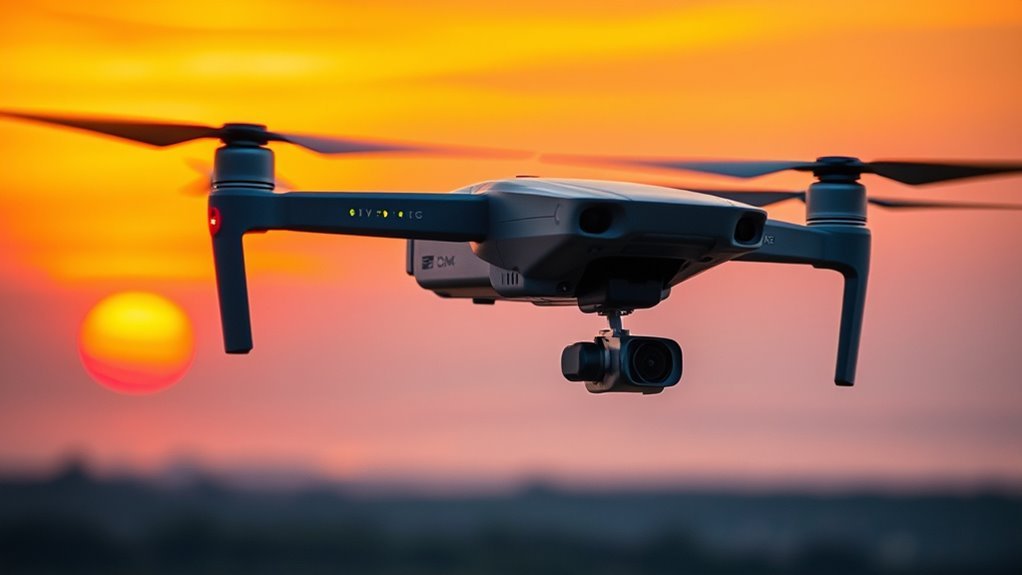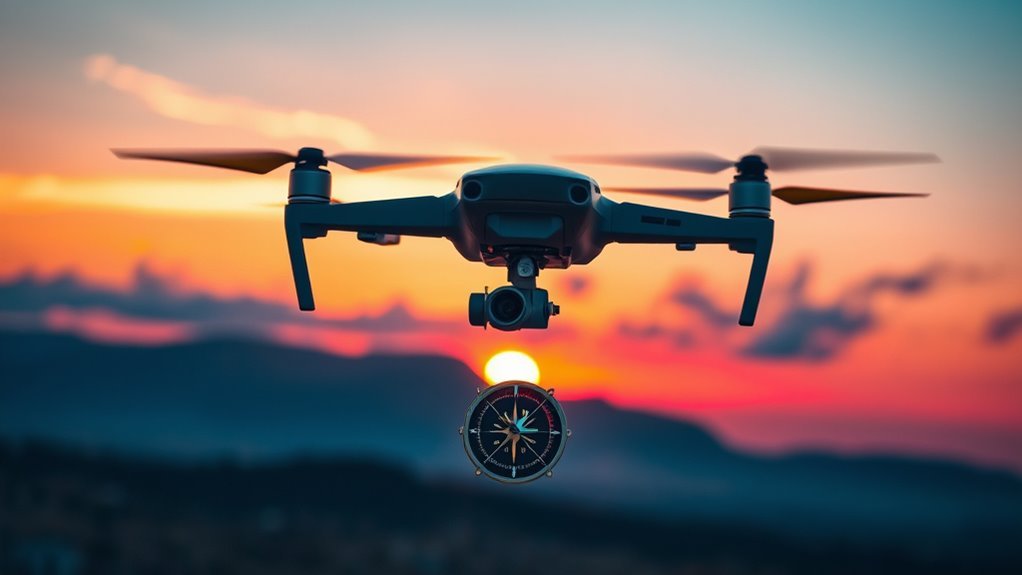You primarily rely on the magnetometer to control your drone’s heading because it provides an absolute reference to magnetic north that gyroscopes and accelerometers alone can’t offer. While gyroscopes measure angular velocity and accelerometers track acceleration for short-term stability, the magnetometer corrects heading drift by sensing Earth’s magnetic field. Proper calibration is essential to counteract magnetic distortions and interference. Understanding how these sensors integrate will reveal how your drone maintains precise directional control in challenging environments.
Understanding Drone Orientation

Orientation is critical for drone navigation, as it defines the drone’s position relative to its environment. You rely on precise orientation data to maintain drone stability, especially when executing complex maneuvers or battling external forces like wind. Achieving accurate orientation requires sensor fusion, where data from gyroscopes and accelerometers combine to provide a thorough understanding of pitch, roll, and yaw angles. This integration minimizes errors from individual sensors and enhances responsiveness, allowing you to control the drone intuitively and freely. As you explore drone flight, mastering orientation enables you to predict and adapt to environmental changes swiftly. Without precise orientation, maintaining stable flight and achieving reliable heading control would be impossible, limiting the freedom and range of your drone’s capabilities.
The Role of the Magnetometer

Although gyroscopes and accelerometers provide valuable data on angular velocity and linear acceleration, they can’t determine absolute heading without external reference. This is where the magnetometer plays an essential role. By detecting Earth’s magnetic field, different magnetometer types—such as fluxgate and Hall-effect sensors—offer precise directional information. When you integrate these magnetometers with gyroscopes and accelerometers, the combined sensor fusion enables reliable, drift-free heading estimation. This sensor integration is important for maintaining your drone’s orientation autonomy, especially in GPS-denied environments. Understanding the magnetometer’s role empowers you to optimize system performance, ensuring your drone maintains accurate heading control. Ultimately, the magnetometer complements inertial sensors by providing the absolute directional reference necessary for freedom in navigation and precise control.
How the Magnetometer Measures Heading

You’ll see that the magnetometer detects the Earth’s magnetic field by measuring its vector components along three axes. By analyzing these measurements, it calculates the drone’s heading relative to magnetic north. Understanding these core functions is essential for grasping how heading determination is achieved accurately.
Magnetometer Functionality Basics
Because the magnetometer detects the Earth’s magnetic field, it can calculate the drone’s heading by measuring the direction of magnetic north relative to the sensor’s position. You’ll find several magnetometer types, like fluxgate and Hall-effect sensors, each with unique sensitivity and noise characteristics. Environmental factors such as nearby ferromagnetic materials or electromagnetic interference can distort readings, so you must account for these to maintain accuracy. The sensor outputs vector data representing magnetic field strength along three axes, which you translate into heading information via calibration and compensation algorithms.
| Magnetometer Type | Characteristics |
|---|---|
| Fluxgate | High accuracy, low noise |
| Hall-effect | Compact, moderate noise |
| AMR | Low power, good stability |
| Environmental Factors | Magnetic interference, temperature variations |
Heading Measurement Techniques
When you want to determine a drone’s heading using a magnetometer, the sensor measures the vector components of the Earth’s magnetic field along three orthogonal axes. By analyzing these components, you calculate the drone’s yaw angle relative to magnetic north, which provides the heading measurement. However, raw magnetometer data can be distorted by local magnetic interference or drone movements. To improve accuracy, sensor fusion algorithms integrate magnetometer readings with inputs from gyroscopes and accelerometers. This fusion filters out transient errors and compensates for tilt and drift, delivering a stable, reliable heading estimate. By leveraging sensor fusion, you gain precise directional control while maintaining the freedom to navigate complex environments without GPS reliance, ensuring your drone’s heading remains accurate and responsive under varying conditions.
Complementary Sensors for Stable Flight
You’ll rely on the gyroscope and accelerometer to measure angular velocity and linear acceleration, providing real-time data for flight stabilization. The magnetometer complements these sensors by offering absolute heading reference, correcting drift inherent in inertial measurements. Understanding how these sensors integrate is vital for maintaining stable and accurate flight control.
Gyroscope and Accelerometer
Gyroscopes and accelerometers serve as the foundational sensors that provide real-time data on a drone’s orientation and movement. You rely on various gyroscope types—such as MEMS or ring laser gyros—to detect angular velocity, enabling precise tracking of rotational changes. Meanwhile, accelerometer applications measure linear acceleration forces, helping you determine the drone’s tilt and motion relative to gravity. Together, these sensors complement each other: the gyroscope offers short-term stability by detecting rapid angular changes, while the accelerometer corrects drift by referencing gravitational pull. This synergy allows you to maintain stable flight and responsive heading control even during dynamic maneuvers. Understanding how these sensors integrate equips you to optimize your drone’s autonomy, ensuring freedom in navigation without compromising accuracy or stability.
Magnetometer Role Explained
Three-axis magnetometers play an important role in complementing gyroscopes and accelerometers by providing absolute heading information based on Earth’s magnetic field. Unlike these inertial sensor types, magnetometers offer a stable reference to true north, vital for accurate drone orientation during flight. However, magnetic interference from onboard electronics or external sources can distort readings, so you’ll need to calibrate your magnetometer carefully and apply compensation algorithms. This sensor’s data integrates with gyroscope and accelerometer outputs in sensor fusion frameworks, enhancing heading accuracy and flight stability. By understanding and mitigating magnetic disturbances, you gain reliable directional control, empowering your drone to navigate confidently. Fundamentally, the magnetometer anchors your drone’s heading to the Earth’s magnetic field, offering freedom from drift inherent in inertial sensors alone.
Calibration of the Magnetometer
Although the raw data from the magnetometer provides directional information, you’ll need to calibrate the sensor to correct for distortions caused by hard and soft iron effects. Magnetometer calibration is essential to enhance sensor accuracy, ensuring the drone’s heading reflects true magnetic north rather than biased readings. You perform this by rotating the drone through multiple orientations, capturing extensive magnetic field data. This data forms the basis for computing offset and scale factors, which compensate for environmental magnetic interference and intrinsic sensor errors. Without proper calibration, heading estimates can drift, undermining navigation reliability. By rigorously applying magnetometer calibration, you regain control over sensor accuracy, empowering your drone to maintain precise heading information, critical for autonomous flight and freedom of movement.
Common Challenges With Heading Accuracy
Even with careful magnetometer calibration, you’ll encounter factors that challenge heading accuracy. Heading interference from onboard electronics or nearby metal structures can distort magnetic readings, leading to erroneous heading data. Additionally, magnetic anomalies in the environment—caused by geological formations or urban infrastructure—can skew sensor outputs unpredictably. To maintain reliable heading control, watch for:
- Localized magnetic disturbances that create false directional cues.
- Electromagnetic interference (EMI) from power lines or radio signals.
- Sensor drift over time due to temperature changes or mechanical stress.
Understanding these challenges is vital for optimizing drone autonomy and preserving your freedom to navigate complex environments precisely and safely. Addressing these issues guarantees your drone maintains accurate heading information essential for stable flight control.
Future Developments in Heading Sensors
As drones become more advanced and operate in increasingly complex environments, heading sensors must evolve to deliver higher accuracy and resilience against interference. You’ll see future developments heavily relying on innovative algorithms that dynamically adapt to varying conditions, reducing sensor noise and compensating for magnetic distortions. Sensor fusion will play a pivotal role, combining data from gyroscopes, magnetometers, accelerometers, and even visual sensors to create a robust, unified heading estimate. This integrated approach enhances reliability, allowing you to maintain precise control even in GPS-denied or electromagnetically noisy zones. By embracing these advancements, your drone will navigate more freely and confidently, pushing operational boundaries while minimizing heading errors. Staying informed about these trends guarantees you leverage cutting-edge technology for peak flight performance.

